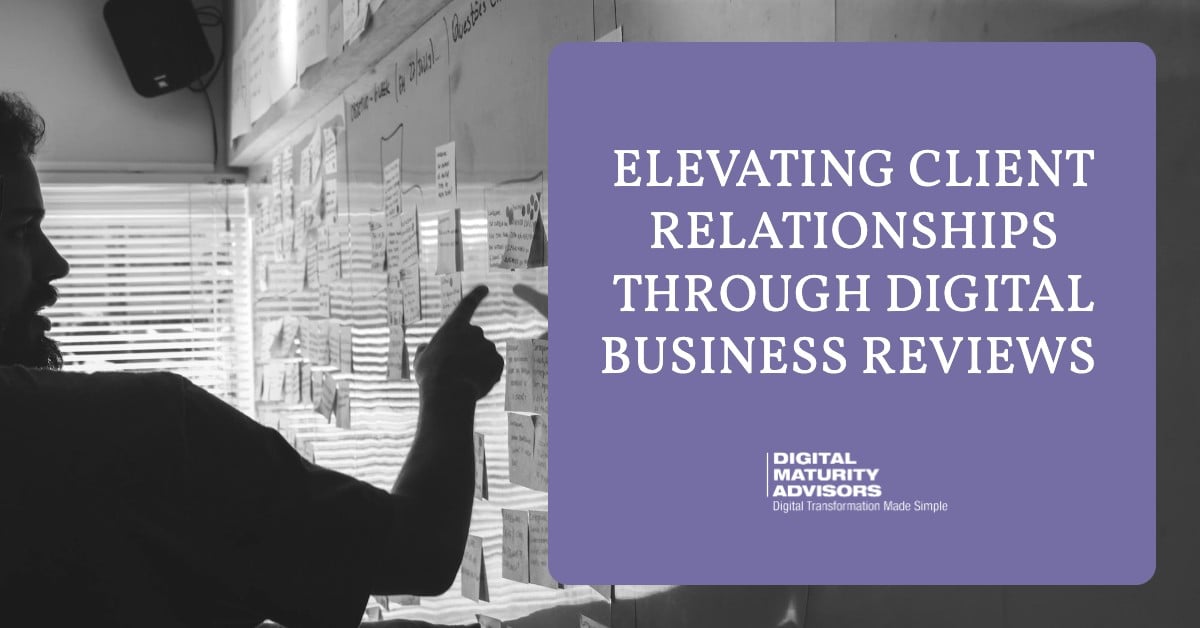Long-Term Client Relationships: Digital Advisory Practice Guide
In today's digital age, businesses need to adopt digital solutions to stay competitive. However, many businesses struggle with digital adoption and...
3 min read
 Lane Smith
:
Sep 6, 2023 5:43:11 AM
Lane Smith
:
Sep 6, 2023 5:43:11 AM

In the dynamic world of digital service providers, including Digital Marketing Agencies, Business Consulting Companies, and IT Service Providers, it's essential to recognize that authentic business relationships cannot be automated. While various tools and best practices are available to streamline and automate digital technology conversations, it's crucial to avoid the common mistake of pursuing digital technology-focused tactical discussions rather than strategic-business-focused Digital Business Reviews (DBRs). In this article, we'll delve into the importance of DBRs, why they matter for digital service providers, and how to enhance these interactions for lasting client relationships.
1. Strategic Over Tactical: Digital service providers often start with technical discussions with their clients, gradually transitioning to executive-level business conversations. While this progression is natural, remaining entrenched in technical discussions can lead to long-term challenges, including decreased profitability, a lack of differentiation, and competitive price pressure. DBRs offer a solution to these issues.
2. Wrong Process: Most DBRs are initiated reactively rather than proactively within the digital service provider industry. They often result from client dissatisfaction or a recognition of the need for regular meetings. This ad-hoc approach lacks clear success criteria and typically relies on tool implementation for structure. As digital service providers mature, their processes shift from ad-hoc to proactive, with DBRs providing a more strategic foundation.
3. Wrong Focus: Initially, DBRs tend to revolve around addressing digital technology-related issues and challenges faced by clients. Reports are generated to resolve these issues through technology-focused conversations. However, as digital service providers mature, the focus naturally shifts from technology to the broader realm of business, reflecting a more strategic approach.
4. Wrong Audience: Many digital service providers initiate conversations with client contacts responsible for resolving technology-related issues, such as office managers, power users, or financial personnel. These individuals primarily engage at a tactical level, focusing on day-to-day problem-solving. To elevate discussions from tactical to strategic, a different audience is required.
1. Stuck in a "Tech Box": Failing to develop DBRs can result in clients viewing digital service providers as merely technical vendors rather than true business partners. This perception limits a digital service provider's strategic value and makes them susceptible to replacement or negotiation. To thrive, digital service providers must be perceived as high-value business partners who engage client executives in strategic discussions.
2. Perceived Salesy: Some digital service providers struggle with DBRs because they feel the process is excessively sales-oriented. Presenting budget reports, warranty issues, and subscription matters can give clients the impression that DBRs are solely about spending more money. To address this, digital service providers should add a strategic layer to their DBRs, emphasizing the value of digital technology investments in the context of broader business objectives.
3. Perceived Less Engaging: Over time, DBRs can become routine, focusing on digital technology metrics and customer satisfaction. Client executives may feel detached from these discussions, leading them to disengage. To prevent this, digital service providers must create DBRs that cater to multiple audiences simultaneously, ensuring that executive-level involvement remains essential.
1. Identify the Client Roles: Use a four-quadrant formula to categorize clients based on tactical/strategic and digital technology/business conversations. Identify key roles, such as CEOs or Business vCIOs, who should engage in business discussions. Regularly connect with the most senior executive to understand their goals and demonstrate your strategic value.
2. Map Your Talking Points: Tailor your talking points to specific client roles. Continue tactical/technical conversations with office managers and power users but establish a new narrative with executives. Use a strategy meeting or digital transformation annual review to engage in high-level business conversations. Develop a scoring mechanism to measure different tactical elements separately and present a "Master Score" at a high level.
3. Run Multiple Layers: Leverage your strategic discussions to secure an annual strategy meeting slot in the client's agenda. This meeting should encompass both business and digital technology aspects, providing a holistic perspective. These high-level discussions and deliverables become a pivotal tool for making DBRs effective, facilitating decisions, and engaging both executives and critical contacts.
Initiating a DBR process may initially seem ad-hoc, tactical, and focused on digital technology. However, digital service providers have a choice in how they progress. They can choose to automate the wrong discussions, creating a process that generates less engagement, price pressure, and a lack of differentiation. Alternatively, they can opt for a business-focused conversation that elevates discussions, connects with key decision-makers, and helps them stand out from the crowd in the competitive digital service provider landscape. Elevating client relationships through DBRs can make all the difference in achieving lasting success and client satisfaction.
In today's digital age, businesses need to adopt digital solutions to stay competitive. However, many businesses struggle with digital adoption and...

In the fast-paced world of Information Technology (IT), Managed Services Providers (MSPs) play a crucial role in helping businesses maintain and...

In today's rapidly evolving digital landscape, businesses are often faced with numerous digital initiatives that lack coordination and alignment....